Erntedankfest « Joyeuses moissons »
17.11.2024 — 22.12.2024
Presentatie van edities, multiples en kunstenaarspublicaties in samenwerking met de Brusselse organisatie JAP (Jeunesse et Arts Plastiques).
Présentation des éditions, multiples et publications d’artistes en collaboration avec l’organisation Bruxelloise JAP (Jeunesse et Arts Plastiques).
Met bijdragen van / avec des contributions de:
Meryem Bayram & Hans Demeulenaere
Pierre Bismuth
Claude Closky
Vaast Colson
Philippe De Gobert
David de Tscharner
Dialogist-Kantor
Peter Downsbrough
Sam Druant
Lise Duclaux
Michel François
Ana Jotta & Pierre Leguillon
Hamer Körmeling
John Körmeling
Arnaud Labelle-Rojoux
Adrien Lucca
Jacqueline Mesmaeker
Ria Pacquée
Manfred Pernice
Laure Prouvost
Stephanie Rizaj
Anne-Marie Schneider
Joëlle Tuerlinckx
Sietske Van Aerde
Martien van Mens
Ken Verhoeven
Oriol Vilanova
Elsa Werth
Yue Yuan
A recurring format, Erntedankfest – “Joyeuses moissons!” traditionally closes the year at LLS Paleis. As a ‘Kunstverein’ the organisation partly relies on financial income through sale of annual editions of collaborating and associated artists. Every year, the Erntedankfest show therefore temporarily transforms the nonprofit art association into a commercial gallery, or shop if you will. In collaboration with different organisations each year, artists’ editions are exhibited and offered for sale. The format’s underlying concept is a necessity and has therefore existed since the organisation’s beginnings – under varying titles. The name ‘Erntedankfest’ – German for ‘annual harvest gratitude festival’, was proposed by artist and LLS Paleis board member Suchan Kinoshita in 2021. Stella Lohaus, head of LLS, happily took it up. The word, which actually consists of three nouns stacked together (‘Ernte’- ‘Dank’- ’Fest’), aptly summarises her aim with this annual format: ’Ernte’ – the harvest, the result of a year; ‘Dank’ – gratefulness for it; and ‘Fest’ – a festivity, a happy occasion.
For the 2024 edition, LLS Paleis collaborates with Brussels based organisation JAP (Jeunesse et Arts Plastiques) and opens its doors once more for a presentation of editions, multiples and artists’ publications – now for the third time under the heading: Erntedankfest – “Joyeuses moissons!”
The old tradition of annual harvest festivals can be found all over the world, in various forms and cultural contexts. As the German word ‘Ernte-dank‘ and also the English ‘Thanks-giving’ already suggest, they are celebrations of gratitude. Festivals of thankfulness for the yield in agriculture and gardens. More broadly, for that which has grown well, borne fruit and nourished communities. LLS’ Erntedankfest is no exception to this. Every year, it celebrates the collaboration with participating artists and their work – its fruits so fine and, as copies of multiples: numerous. A good harvest, so to speak. In the 2024 edition, some of the publications and multiples consist of a number of rather exact copies of a work. Others are varying specimens and come closer to the idea of a series.
There’s no two apples alike on a tree and the same is true for the samples of many of the multiples here. To name a few such editions of unique copies: Sietske van Aerde’s Dirty dress and Dirty shirts take existing stains on clothing as points of departure and transform them into hand-painted motifs. No two stains are alike and neither are the paintings. The same is true for Hamer Körmeling’s original drawings of shoes from the series Wandelen op blauwe bollen. Naturally, each drawing differs – more or less, from the other. The thread patterns in the fabric of Stephanie Rizaj’s edition Alma – a bomber jacket made from moving-blankets, differ already by default of production. Underneath moreover, different colours of lining appear in the individual copies.
Carrying further the metaphor of the artwork as crops or fruit – part of and grown from the body of work of an artist, a saying comes to mind: The idiom ‘to compare apples and oranges’ advises against doing just that. Regardless, it’s an interesting endeavour. ‘Apples and oranges’ here – the different works within the Erntedankfest exhibition, share several points of commonality. On the ground of what appears to be no strict thematic selection of works, connections grow nevertheless.
Several of the works share, for example, a starting point of something found, of a coincidental encounter or an element of chance. This could be the before-mentioned stains on shirts and varying patterns of chosen fabric – or, as in Ken Verhoeven’s Vroege momenten samen (engl.: ‘early moments together’) an algorithmically generated title for a group of smartphone photos. Appropriating this title, the work consists of a screenshot placed in a tablet-device case which assumes the function of a frame. As a readymade from the internet, the case is itself an objet trouvé.
Reproductions II and Reproductions III by Oriol Vilanova are collections of photographs of flea market arrangements, framed in a way that presents them as still lives or carefully considered installations. His work Février 2024 takes samples of the ever same, mass produced brochure for folding ladders as wrapping, frame and context for housing different second-hand postcards of ‘escaliers en colimaçon’ (spiral staircases) inside each copy. The postcard – per se a symbol for circulation, and the straight, pragmatic folding ladder of the advertising flyer in juxtaposition with images of beautifully turning stairs, reminiscent in their shape of the golden cut, amount to a subtle meditation on linearity versus circularity.
Due to their nature of reappearing in different contexts and purposes, found objects may inherently speak of circularity. With a sincerity in facing the question of how to avoid unnecessary production, LLS Paleis is generally interested in working with residues and what already exists, claiming the very positive meaning and potential of the term ‘leftovers’: that which is already available, can be reused and live on. For the 2023 edition, LLS Paleis’ Erntedankfest carried the byname Décroissance – French for ‘degrowth.’: It was the theme and leitmotif of that year’s issue, and remained a central objective in all subsequent exhibitions: A commitment to produce no more than necessary in a world that suffers heavily from overproduction and its effects. Aiming at and concerned with all the artworks that sit in basements and drawers, the 2023 invitation asked participating artists to exhibit work that they had already made. Consistently, the handouts accompanying the exhibition were printed on the back of surplus leftover printouts from previous events and occasions.
Roaming the room this year, straw rustles under the feet, its subtle smell fills the air. The exhibited editions, multiples and publications are displayed on stacks of hay and one pedestal – reminiscent of a previous exhibition and wrapped in golden paper. The idea for this presentation is a contribution of this year’s collaborator Thibaut Blondiau from JAP. Instead of going for the construction of a material-intensive scenography from new resources, it’s a solution that makes use of what already was in the space. The added hay – a wink to the title Erntedankfest, is borrowed and won’t go to waste afterwards. In a way, this proposal can be seen as Thibaut Blondiau’s response to the concept of degrowth which Stella Lohaus introduced with the previous edition of Erntedankfest.
To return to recurring themes of the 2024 edition, ‘clothing’ is one to be quickly detected. In addition to the already mentioned drawings of shoes, Harmer Körmeling also exhibits the original pair they’re based on (‘size 39, already worn’), as well as a series of ties, tailored from shirt collars and their button plackets. In Het nieuwe normaal (‘the new normal’) blouse meets tie, two pieces of clothing merge together here, and with them two different expressions, purposes, ideas and codings. With Col d’or (golden collar), artist duo Dialogist Kantor proposes another way to adorn ones neck – and possibly also those of friends and acquaintances. Col d’or – a pattern to make paper collars, is an artwork in edition: A multiple itself and simultaneously – as a template, also a tool to produce an unlimited number of multiples with. Blue collar, white collar – countless golden collars for artists and those who appreciate art.
Col d’or, as a playful tool, leads to another theme that runs through several works of the show. Namely, a sense of childhood and play. The aforementioned toy aesthetics in Ken Verhoeven’s work reoccur in Manfred Pernice’s edition freizeit which uses an actual toy, a wooden cake in several pieces as its central ingredient. One piece of it per copy is arranged on a cheese platter or cutting board, together with pins and tiny found objects in plastic. Pierre Bismuth’s Art for all that can be understood by human beings is a jigsaw puzzle. It depicts the eponymous sentence in a font that resembles the letters and numbers used for the ‘verification of being human’ online (‘captcha’). The edition A childhood brings together the pages drawn in pencil by artist Jacqueline Mesmaeker in Francesca Allinson’s book of the same name, which was given and dedicated to her by an officer in the RAF in 1945. One sculpture a day keeps the doctor away by David de Tscharner features the silhouettes of sculptures produced over one year, and takes the inviting form of colouring book.
In another artist book – 4 colors by Vaast Colson, the participation via pen seems to have already happened. It contains 16 multiple-choice questions, all filled out, apparently with one of those four color ballpoint pens that can be switched from black to blue to green to red. ‘Intersect’ by Peter Downsbrough and Sept et pas sept by Claude Closky are two examples of graphic, formal explorations while Elsa Werth’s Abracadabra! is an experiment in language that explores on 48 pages, various possible constellations of switching around the letters of its title. Pia Pacqueé’s Street Rambling Kathmandu is a photographic journey which arrives at a list of terms and descriptors that feel like an invitation to then be kept in mind when going through the images again. Mes prisons ou memoirs d’un condamné (‘memoirs of a convict’) by Michel François presents a facsimile of a notebook discovered at a flea market. It was written by A.D. in the Louvain penitentiary following his arrest on 27 December 1899. The theme of memory(/-ies) is another subtle sub-current of the show.
Next to the many artist books, several other works refer to books as well: The title of Oriol Vilanova’s Reproduction III for example goes back to an old booklet containing 13 works by Matisse, from which the artist drew inspiration for this edition. Yue Yuan’s featured edition is a folded paper that states its title on its front as an invitation: Open this paper under the light of the sun. The artist says about it: “It was by chance that I was given a copy of Maria Nordman’s book De Civitate, a catalogue of her sculptures (…) I was immediately attracted to the photograph on the first page of the book which showed a reflective installation on the façade of a building, with a room of this building illuminated by the reflected light. (…) a car stopped by chance outside my window and a strong reflection illuminated this page, I photographed this moment.” Jaqueline Mesmaeker’s Lewis, a ‘People’s Edition’ of Alice’s Adventures in Wonderland takes the book’s binding with only one page and transforms it into a small sculpture, held by a little rabbit and two wooden cubes for feet. Meryem Bayram & Hans Demeulenaere’s collaboration W hole originally set out to become a book but took a different form in the end. The artists collected various objects with holes, ranging from a chair to a tube, to a piece of jute webbing. Both worked on their own terms and combined the outcomes in the end. The result is an artist edition in two parts.
Several of the editions are collaborations, and another repeated theme is correspondence: The poster Potpourri (Avant la lettre) by Ana Jotta and Pierre Leguillon unfolded as a mail art project between the two artists, who were adding and rearranging elements in turn, sending the work back and forth. Lise Duclaux’s several editions of postcards offer themselves to anyone for potentially starting a correspondence. Handwriting – whether on Laure Prouvost’s untitled edition, paired here with photos and brushstrokes, on the cover of the aforementioned artist book A childhood, in the form of a facsimile in Mes prisons ou memoirs d’un condamné, as an element of Hamer Körmeling’s drawings, or in Sam Druant’s riso print Setting the stage for the hormone play which carries its title written out by hand as part of the image – is another example of a material quality that comes back throughout several works of the exhibition.
An additional, humorous quality – wrapped around the whole of the presentation, is the offer to consider the included pieces as gifts, as stated on the invitation to the Erntedankfest: “Original Christmas gifts from 2 to 850 euros!” Between the editions displayed on straw bales and golden paper wrapped pedestal that make up the scenography of this year’s edition, a certain Christmas spirit might actually be evoked, as a reference to agriculture and harvest is made. Rumour has it that some passers-by might have walked in, searching for a baby Jesus, ox and donkey. It’s something else that can be encountered here. As the last show of the year, Erntedankfest celebrates another year of projects and collaborations at LLS Paleis with a presentation of over 30 works by 31 artists:
Meryem Bayram & Hans Demeulenaere, Pierre Bismuth, Claude Closky, Vaast Colson, Philippe De Gobert, David de Tscharner, Dialogist-Kantor, Peter Downsbrough, Sam Druant, Lise Duclaux, Michel François, Ana Jotta & Pierre Leguillon, Hamer Körmeling, John Körmeling, Arnaud Labelle-Rojoux, Adrien Lucca, Jacqueline Mesmaeker, Ria Pacquée, Manfred Pernice, Laure Prouvost, Stephanie Rizaj, Anne-Marie Schneider, Joëlle Tuerlinckx, Sietske Van Aerde, Martien van Mens, Ken Verhoeven, Oriol Vilanova, Elsa Werth, Yue Yuan.
Emilia Keller
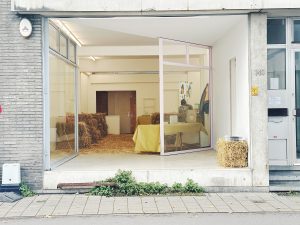
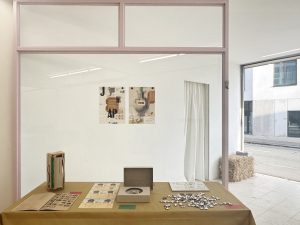
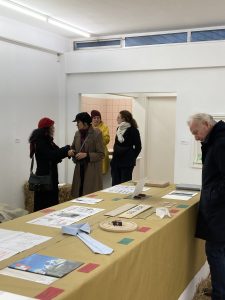
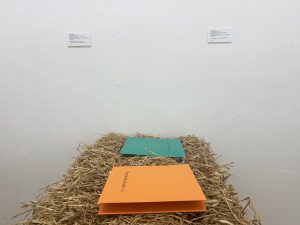
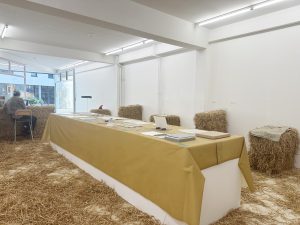
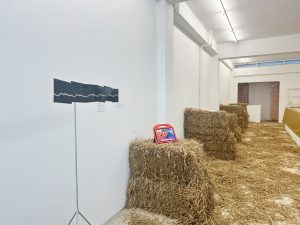
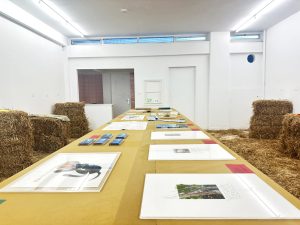
Le 15 décembre à 15 heures / 15 december om 15 uur: Sunday afternoon talk avec / met Toni Geirlandt et / en Carlos Montalvo (DIALOGIST-KANTOR) et / en Thibaut Blondiau (JAP). Interview réalisée par / interview afgenomen door Indra Devriendt.
Début : 15 heures / Start: 15 uur
Langue : anglais / Voertaal: Engels
Suivi de Kaffee und Kuchen. / Gevolgd door Kaffee und Kuchen.
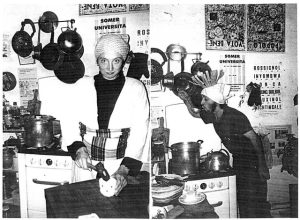
Dialogist-Kantor, Doppelmoppel (Perdrix 1995), 1995
Tout le monde est bienvenu ! Iedereen welkom! Everybody welcome!
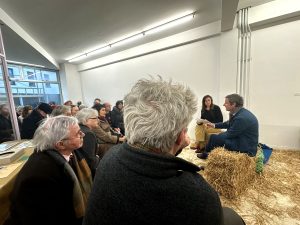
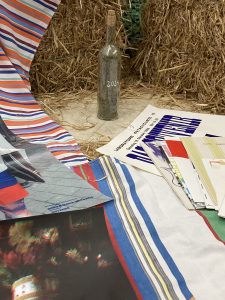
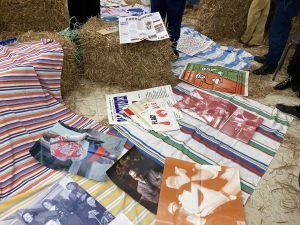
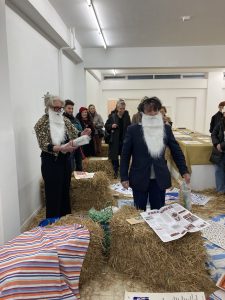
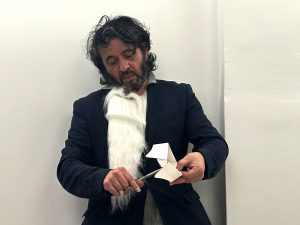

LLS Paleis dankt de deelnemende kunstenaars, Dora Brams, Indra Devriendt, Toni Geirlandt, Emilia Naomi Keller, Carlos Montalvo, Theo Montalvo, Ria Pacquée en Laura Vandenbroucke.
LLS Paleis wordt gesteund door de Vlaamse overheid en gesponsord door Duvel Moortgat en Ghysel & De Lombaerde accountancy & fiscaliteit.
